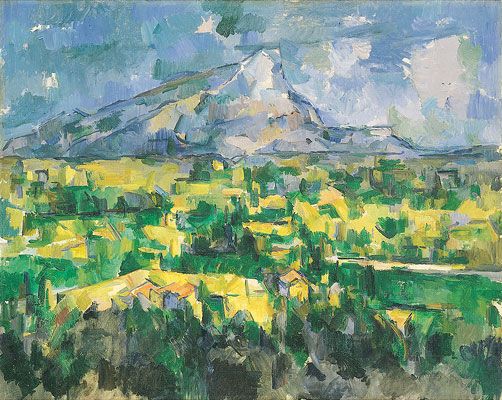Summary of Chaïm Soutine
Increasingly becoming a household name, Chaïm Soutine's work transcends the movements that dominated the avant-garde during his lifetime. He chose to eschew the dominant early-20th-century avant-garde trends of Expressionism, Cubism, Dada, and Futurism in favor of a more traditional approach, honing his skills as a portraitist, landscapist and painter of still lifes. His paintings went on to influence some of the most radical and avant-garde artists of subsequent generations. His impasto technique, which he developed to the point of mastery, combined with a highly accomplished use of color and free, gestural brushwork equally sparked the interest of the postwar Action Painters including Willem de Kooning and Jackson Pollock and their realist counterparts in the UK, such as Francis Bacon and Lucian Freud.
Accomplishments
- Soutine looked to established masters like Rembrandt van Rijn and Jean Baptiste Siméon Chardin for inspiration, often referencing subject matter from their paintings in his own work. However, although many of his paintings contain clear references to historic works, Soutine reinterpreted each theme, translating it into his own modern vocabulary and offering a fresh take on well-known masterpieces.
- A recurrent theme in Soutine's work is that of food, which features frequently in his vivid still lifes, with the focus placed on the bodies of animals used for food. The artist's complex relationship to food, with its prominent place in Jewish ritual as well as its scarcity in his youth and early career, lends this common theme a deeper, more personal meaning.
- Although frequently labeled within art history as an Expressionist, Soutine's subjects and paintings are far from the typical urban angst commonly portrayed by the German Expressionists. Instead, his mastery of the visual and physical properties of oil paint set a precedent that would reappear in subsequent decades, starting with the Abstract Expressionists who learnt from his gestural brushwork and impasto technique.
- Soutine's portraiture was essentially a long-term study of (mostly) working-class men, women and children, amongst whom he lived and with whom he clearly felt more comfortable. The people we see in his portraits were not models dressed up to play the role of pastry chefs, waiters and domestic servants. They were real people, who Soutine captured as they went about their labor and daily lives and who the artist treated with the same level of respect and honesty as his wealthier and more influential sitters.
- Soutine's most celebrated and influential landscapes are those produced early in his career while he was living in the southern French town of Céret. This is a rare achievement - typically, an artist's so-called 'late' works are more usually viewed as the culmination of their achievements. Soutine, however, painted the much sought-after Céret landscapes when he was only in his late twenties.
Important Art by Chaïm Soutine
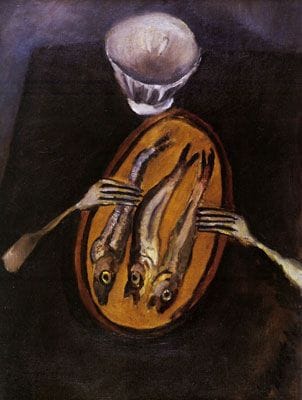
Still Life with Herrings
Soutine endured extreme poverty while growing up and later when he emigrated to Paris. He also had constant stomach ulcers - the result of childhood malnutrition and chronic stress - that often made eating painful or impossible. In this painting, an early study made not long after arriving in Paris and when he was living in poverty in the famous artist studio complex, La Ruche ('the beehive'), he cleverly conveys a sense of hunger by presenting uncooked fish on an otherwise empty table. He also likens the forks to arms, which reach in from opposite ends of the plate to grab the slender herrings.
Many writers on Soutine have also commented on the fish in this work, which look as if they might jump off the plate at any moment. Soutine was particularly accomplished at portraying a sense of aliveness in his subject-matter (especially in the dead animals he painted), a skill to which this work attests. Thus, even at this very early stage in his career, Soutine was already demonstrating his unique ability to powerfully animate his subject-matter, even when that subject is dead (or inanimate). As British art critic David Sylvester commented, Soutine's "concern with the process [of death] shows in those writhing fish and convulsed fowls of his which seem in the process of dying". Nowhere is this observation more clearly borne out than in Still Life with Herrings. As contemporary artist Chantal Joffe said about this painting, "I saw Soutine's [Still Life with Herrings] on my foundation course and I remember it had this quivering kind of emotion. He's never tried to make his work real. Rather it's his version of real".
Oil on canvas - Private Collection
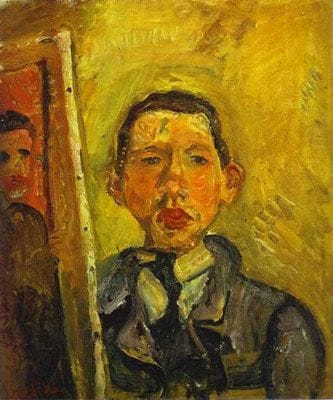
Self-Portrait
Soutine painted only four self-portraits, three of which were created in the early part of his career. This example shows him standing next to a painting (which is presumably resting on an easel) in a composition that is distinctly reminiscent of self-portraits by Vincent van Gogh (e.g. Self-Portrait as a Painter from 1887/88) and Paul Cézanne (e.g. Self-Portrait with a Palette from 1885). In his own portrait, however, and in a notable departure from tradition, Soutine has chosen not to depict himself holding a palette and brushes - the traditional tools of a painter. Instead, he is shown silently gazing out at the viewer with a disconcertingly direct gaze. The portrait thus creates an immediate, intimate connection between artist and spectator - which is where the power and significance of this image lies.
The dark suit and tie Soutine wears in this work can be found in other artists' portraits of him (for example those done by his friend, Amedeo Modigliani in 1916-17), and the self-likeness he has created in this painting is a close match to photographs of him. There is also a clear connection to Post-Impressionists like Vincent van Gogh in this image (whose work Soutine is reported to have disliked), which can be seen in the vibrant palette as well as the loose brushwork Soutine used to create this image.
Oil on canvas - The Art Museum, Princeton University, Princeton, NJ
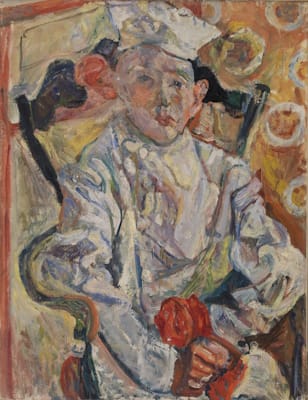
The Pastry Chef (Baker Boy)
Soutine was on occasion referred to as a "servant painter" due to his many portraits of cooks, maids, and other wait staff - even random people he encountered on the street. The Pastry Chef (Baker Boy) is perhaps the best known of Soutine's pastry cook paintings which caught the attention of Albert Barnes in 1922.
Widely regarded as a masterpiece of color, the handkerchief is the focal point of the work, along with the young man's very large ear. Despite being partially hidden in the young man's grasp, the splash of red in the handkerchief draws the viewer's eye throughout the composition. The somewhat exaggerated features of the young man and his absent gaze echo those found in some of Soutine's self-portraits, suggesting that Soutine saw himself in this young man. The flatness of the representation and the thick impasto of the paint application would later reappear in works by the Art Brut painter and sculptor Jean Dubuffet, further demonstrating Soutine's impact on modern art. Dubuffet said: "The objective in painting is to animate a surface which is by definition two-dimensional and without depth [...]; let the surface speak its own language and not an artificial language of three-dimensional space". This statement, in which Dubuffet describes his own approach to painting, could easily describe any of Soutine's works, including The Pasty Chef with its flatness of representation and animated, energetic surface.
Oil on canvas - The Barnes Foundation, Philadelphia
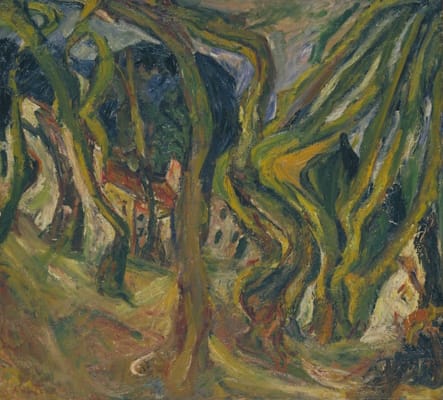
Landscape at Céret
Not long after Soutine became acquainted with the dealer Leopold Zborowski, he was sent by Zborowski to the village of Céret in the Pyrenees foothills, the very place where Pablo Picasso, Georges Braque, and Juan Gris vacationed and discovered much of their inspiration for Cubism. Although interested in Cubism and its intellectual pursuits, Soutine refrained from experimenting with the style in his own art. Instead he preferred to lend his canvases a vibrancy, with multiple sweeps and curves that gave his landscapes an unsettling beauty. Soutine hated Céret, but ironically the landscapes he produced there (around 67 in total), have become some of his most celebrated works.
Despite the seeming abstraction and 'distortions' in works such as Landscape at Céret, it is possible to identify nearly all the locations which he painted in the town, speaking to the accuracy of his observational skills and to his deep familiarity with the area. The energetic brushwork of the trees and the flowing lines of the work foreshadow the gestural quality of the Action paintings of the Abstract Expressionists. As curators Simonetta Fraquelli and Claire Bernardi explain, in the context of postwar America, Soutine's canvases "became a touchstone for artists exploring the concepts that came to define the new American painting". They also note that some of the most prominent and celebrated of the Abstract Expressionist painters - particularly Jackson Pollock, Willem de Kooning and Jack Tworkov - examined and adapted Soutine's technique of "free and uninhibited use of pictorial gesture combined with a strong and intimate attachment to the figure". Indeed, as art critic Harold Rosenberg famously wrote in 1952, the new Action Painters of America could have acquired their style by "putting a square inch of Soutine or Bonnard under a microscope".
Oil on canvas - Nagoya City Art Museum
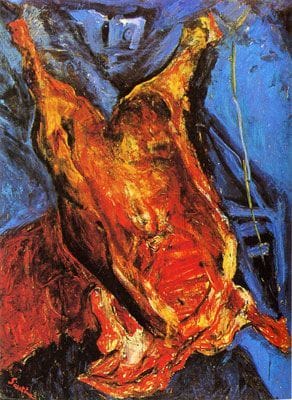
Carcass of Beef
Soutine returned to the subject of the beef carcass repeatedly over the course of his career, a subject influenced by his adoration of Rembrandt's Slaughtered Ox (1655) in the Louvre. However, while other artists painted similar subjects, Soutine's portrayal of this slaughtered animal is particularly emotive and powerful: he has covered the entire canvas with bright, saturated color - choosing a particularly bold red pigment to represent the fresh blood dripping down the carcass - and also displayed the carcass split open, as if bearing its soul to the viewer.
After hanging the side of beef bought at a Parisian slaughterhouse in his studio, he had his assistant fetch a bucket of fresh cow's blood every few days and, while painting this work, Soutine would repeatedly pour blood over the carcass to ensure it maintained the bright color of freshly cut beef. Meanwhile, his assistant fanned away flies and neighbors complained to the police about the smell, even causing health inspectors to almost cart the beef away.
A direct link to this painting can be found in the work of Francis Bacon, who picked up the same subject in his famous painting, Figure with Meat (1954), creating an instant visual connection with Soutine's work.
Oil on canvas - The Albright-Knox Gallery, Buffalo, NY
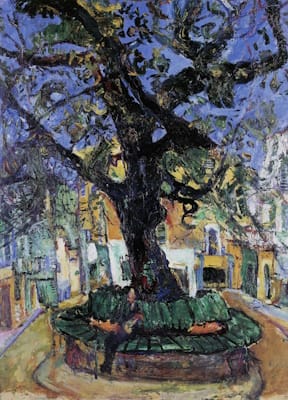
Great Tree of Vence
Soutine painted this tree at least seven times when he was staying in Vence, near Cagnes-sur-Mer, at the end of the 1920s. While each painting in the series communicates a very different atmosphere - ranging between a grey, brooding sky and the bright, sunny day depicted in Great Tree of Vence - the tree takes center-stage in all the Vence works. The saturated blue of the Mediterranean sky fills the top half of the composition in this work, with the many winding branches of the tree overlaid on top, creating an almost decorative effect and surface. In an unusual addition, a figure sits on the bench which encircles the tree's trunk, relaxing under the shade of its branches (human figures are absent from the majority of Soutine's landscapes).
This is a complex, highly detailed composition, which Soutine has handled skillfully in its various parts: the numerous, multicolored buildings behind the tree, the intricacies of the figure on the green bench, and the complex anatomy of the tree itself. All elements are all balanced in a flat picture plane, which mostly defies a sense of three-dimensional space. In this work, Soutine thus not only demonstrates his skill as an expert colorist, but he also shows himself to be a keen and accurate observer - an accomplished plein air painter who powerfully captures the complexity of the scene in front of him.
Oil on wood
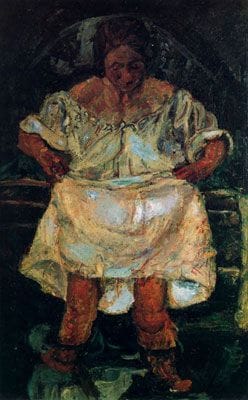
Woman Entering the Water
Woman Entering the Water is one of Soutine's most recognizable and famous paintings. Here, he confronts his model head-on, placing her in the center of the composition and depicting her directly from the front. Her dress, skin, and posture are all static while not entirely motionless, much like the water she is entering. Soutine's rapid brushwork flattens the figure and her surroundings, eliminating naturalistic depth in favor of a condensed, ambiguous space.
In portraits like this, Soutine again successfully synthesized his own particular vision with Rembrandt's subject-matter and use of exaggerated shadow in A Woman Bathing in a Stream from 1654. While the composition refers back to Rembrandt, however, Soutine represents the figure with quick, visible brush strokes and an eye for abstraction that is entirely his own; he also obscures the woman's body in favor of the texture and complexity of brushwork used to render her garment. Soutine thus pushes the subject up to the front of the image, removing most reference to the background and placing the focus on his handling of the paint, a clear precedent for the path of the later Abstract Expressionists.
Oil on canvas - Private Collection
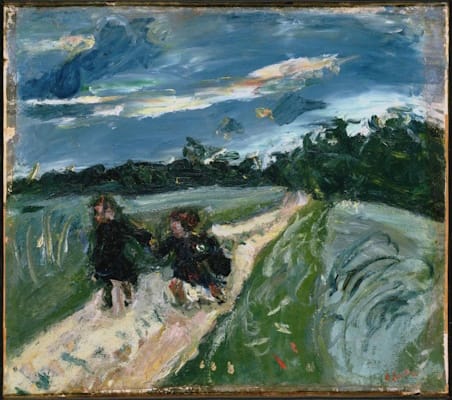
Return from School After the Storm
Soutine painted this richly colored, stormy-looking landscape during the summer of 1939 (just before the outbreak of World War II) when he was living the village of Civry-sur-Serein, not far from Auxerre. His companion at the time, a German, Jewish refugee, Gerda Groth, recounts in her memoirs: "The road leading to Isle-sur-Serein was then planted with large poplar trees and the late afternoon sun shone magnificently through the foliage. Soutine made several paintings of this road." It is this road that Soutine depicts in Return from School After the Storm. Two young children walk hand-in-hand along the narrow path that runs through and out of the picture. The brooding sky above them signals an oncoming storm, which has perhaps caused the children, who Soutine paints very much in motion, to hurry to reach home before the rain starts to fall.
Soutine's acknowledged mastery of the impasto technique is particularly evident in his skillful depiction of the sky in this painting, in which streaks of lighter colors - red, yellow, green and white - have been layered on top of, and mixed with, the darker blue brushwork to create the powerfully evocative impression of sunlight peeking through dark storm clouds. The visible, gestural brushwork has also been used to create the impression of key textures in the image: the dark foliage of the trees in movement, long strands of grass being blown in the wind, the stony dirt of the path, and so on. Return from School After the Storm shows Soutine at the height of his skills, employed in the service of depicting one of his favorite subjects: the natural world.
Oil on canvas
Biography of Chaïm Soutine
Childhood
Chaïm Soutine was born and raised in the small shtetl (a small town or village with an Orthodox Jewish population) of Smilavičy, near Minsk, in what is present-day Belarus. Soutine and his family spoke Yiddish, some Russian and wrote and read Hebrew. Soutine grew up within traditional Talmudism, a heritage that he chose not to reference directly in his paintings (unlike some of his contemporaries, for example - Marc Chagall). The tenth of 11 children, Soutine's father was a tailor and Soutine was raised in poverty. His upbringing was fairly typical of Russian-born Jews during this era, who were forced to endure persecution and discrimination from a hostile government. In addition, his family (and community) were subject to Talmudic proscriptions regarding the making of images. Soutine's early interest in drawing is thus said to have incurred opposition from his Orthodox father and his Jewish community. According to an oft-recounted story, the young Soutine was beaten as punishment after drawing a rabbi. His friend and fellow artist, Marevna (aka Marie Vorobieff), who shared a studio building with Soutine, reported the suffering Soutine experienced within the shtetl of his youth. This suffering is something that he preferred not to discuss later in life.
Around the age of 10, Soutine first traveled to Minsk, and from there, in 1910, to Vilnius, Lithuania. In Vilnius he studied for three years at the Vilnius Drawing School (which no longer exists), one of the few academies of its kind that accepted Jews as students. While enrolled, Soutine was exposed to artists from the Russian avant-garde as well as older Russian masters like the renowned seascape painter Ivan Aivazovsky and the landscape artist Fyodor Alekseev. Soutine excelled at drawing and painting during his early tutelage.
Early Training
Following his training at Vilnius, at age 20, Soutine traveled to Paris with fellow student Michel Kikoïne and enrolled at the École des Beaux Arts, working for two years in the studio of Fernand Cormon, a highly respected historical painter. He also began making frequent visits to the Louvre and conducted close studies of works by the likes of Francisco Goya, El Greco, Jacopo Tintoretto, Jean-Auguste Dominique Ingres, Jean-Baptiste-Camille Corot and Gustave Courbet. The paintings of Rembrandt van Rijn, however, made a distinct impact on the young Soutine, who came to adore the master's portraiture, still lifes, and dramatic use of light. Later in life, Soutine reportedly made several trips by train to Amsterdam and slept on a park bench outside of the Rijksmuseum, just for the chance to spend more time with the museum's Rembrandt collection.
In 1915, while living in La Ruche - literally "The Beehive" - a purpose-built artist's residence in the southwestern outskirts of Paris, friend and fellow artist Jacques Lipchitz introduced Soutine to Amedeo Modigliani, an Italian-Jewish émigré, who influenced Soutine's early career. Soutine stated of their friendship, "He gave me confidence in myself" but later told friends that he blamed Modigliani for leading him to drink despite the knowledge of his increasingly painful and serious stomach ulcer. A great admirer of Soutine's early portraits and still lifes of food, Modigliani soon introduced Soutine to his art dealer, Leopold Zborowski, who almost immediately offered to represent Soutine. Modigliani and Soutine's friendship is evidenced in paint by a series of four portraits Modigliani made of Soutine between 1915 and 1917. Interestingly, as far as we know, Soutine never painted Modigliani in return.
Modigliani was not Soutine's only friend in this early stage of his career. He also developed friendships and professional relationships with a number of other Jewish émigré artists based in Paris at the same time, such as Michel Kikoïne (mentioned above as a friend from Vilnius), the Belarussian-French painter, Pinchus Krémègne (who he had also met in Vilnius), and Polish-French painter, Moïse Kisling. In this context, Soutine began to establish a name for himself in the Parisian art scene alongside his contemporaries, who were also coming to the attention of notable art dealers and collectors.
Mature Period
Between 1919 and 1925, with the support of Zborowski, Soutine relocated from Paris, first to the small town of Céret in the French Pyrenees (near Perpignan and the Spanish border) and then, in 1923, to Cagnes-sur-Mer on the French Riviera, near Nice. In both locations he painted the local people, with whom he lived and who he knew well, and he also produced landscapes prolifically during both periods. The Céret landscapes in particular have become celebrated as a unique body of work prefiguring Abstract Expressionism in North America. Abstract Expressionist artists such as Willem de Kooning and Jackson Pollock looked to Soutine's work for inspiration after World War II, at a time when American art critics (such as Clement Greenberg) were keen to establish New York (instead of Paris) as the new center of artistic innovation. The Abstract Expressionist action painters, led by Pollock and de Kooning, aimed to produce art that was expressive, directly painting their emotions and impulses on to the canvas. To achieve this, they used large brushes, gestural marks, splashing and dripping paint on to the canvas and other techniques that engaged the body directly in the process of creating their work. Soutine's Céret landscapes, with their dynamic paint surfaces, sweeping application of multiple colors and lively impasto brushwork, offered New York artists a key point of reference from which to develop their own new techniques.
While Soutine is known to have been unhappy in Céret - when he spoke to his friends about his time in the town, he was reported to have said that his Céret years didn't count! - he nevertheless prolifically painted the town and its surrounds. While he continued to produce still life works and numerous portraits at this time, it is undoubtedly his landscapes that have become synonymous with his so-called 'Céret period'. The Place de République and Place de la Liberté (both well-known Céret landmarks) appear frequently in his work from this period, as does the Romanesque Church of St. Peter in the center of Céret's Old Town. He also worked in series during this period, returning to paint multiple images of the same model, scene or still life subject. This practice of intently and repeatedly studying his subjects became a hallmark of Soutine's work from this point onwards.
Leaving Céret for Cagnes-sur-Mer in 1923, Soutine continued to paint landscapes featuring local landmarks and scenery, but his palette underwent a significant change. Moving away from the darker hues of the Céret landscapes (characterized by browns, yellow-ochre and dark greens), he turned to a brighter, livelier palette of saturated yellows, blues and reds to capture the sunnier Mediterranean climate of the Alpes-Maritimes. In Cagnes, Soutine also expanded his still life practice significantly. Food in particular was a recurrent theme in his work from this period. While early examples of this interest include Still Life with Tureen (1914-15) and Still Life with Herrings (1916), a decade later in Cagnes more expansive examples followed like paintings of ray fish, Flayed Rabbit (1924) and his series of beef carcasses from c. 1925. In his repeated use of beef, poultry, fish, and other animal carcasses as subject matter over the course of several decades, Soutine's work sits firmly within a long, French art-historical tradition of still life painting (in which game animals appear frequently).
Following a two-year residence in Cagnes, Soutine returned to Paris in 1925 where he was to remain until the outbreak of the Second World War. The 1920s and 1930s were Soutine's most productive and commercially successful years. In 1922, American collector Albert C. Barnes was taken with one of Soutine's portraits of a pastry cook (painted in Céret) while visiting Soutine's second dealer, Paul Guillaume. Guillaume privately showed Barnes more of Soutine's work, the bulk of which (around 50 canvases) the collector promptly purchased. Dr. Barnes's patronage raised the price of Soutine's work and allowed him to live in financial stability for the rest of his career. His first dealer and patron, Zborowski had died in 1932, followed by Guillaume in 1934, but from the early-1930s onwards, Soutine was in receipt of patronage from the wealthy French collectors Madeleine and Marcellin Castaing. The couple regularly welcomed Soutine to stay at their summer home in Lèves from 1930 to '35. They also engaged models and found canvases for him, and he often painted their domestic staff.
During the 1930s, Soutine participated in a number of well-received exhibitions in Paris and abroad, including a solo show in Chicago and a group exhibition in 1937 entitled, The Origins and Development of International Independent Art in Paris, held at the Musée du Jeu de Paume. During this decade, Soutine turned his attention most consistently to portraiture and chose to paint mainly (though not exclusively) female subjects. While he completed three portraits of his patron, Madeleine Castaing, around this time (e.g. Portrait of Madeleine Castaing, c. 1929, most of the sitters who appear in his portraits are (now) unknown women and children who Soutine met in the course of his daily life. Woman Entering the Water, falls within this period and it was also at this time that Soutine painted the only nude he is known to have undertaken: Female Nude (Eve) (1933).
Late Period and Death
On the eve of World War II, Soutine had been living with his partner, Gerda Groth (who Soutine affectionately named 'Mme Garde'), a German-Jewish refugee who fled to Paris in 1935. Gerda was forcibly removed to a camp for German nationals in 1940, as the Nazis neared France. At the loss of their stable relationship, Soutine was distraught. However, later that year Soutine became romantically involved with Max Ernst's former wife, Marie-Berthe Aurenche, who remained his partner until his death.
During the occupation of France, Soutine was forced to remain mostly outside Paris and in hiding, for fear of being captured by the Gestapo, moving from place to place. These extremely difficult circumstances - in which it is surprising he was able to paint at all - understandably brought about a change in his subject-matter. Soutine had all-but ceased to produce still lifes during the 1930s, instead painting a small number of images of live animals, including horses and pigs. Some of these were completed when he was in hiding during the occupation and reflect the rural context in which he was forced to live. For the same reason, landscapes also feature frequently in his later / wartime oeuvre, capturing the open spaces and tree-lined roads and paths of the rural south.
The extreme stress of being hunted by the Nazis and being forced to move from place to place aggravated Soutine's ulcers. In early August 1943 was rushed to a hospital in Chinon due to severe stomach pain, but his condition required an emergency surgery in Paris. The journey to Paris took over 24 hours, and Soutine died of a perforated ulcer on August 9, 1943, at 50 years old. He was buried in Montparnasse Cemetery.
The Legacy of Chaïm Soutine
Despite not conforming to any specific movement or style, Soutine secured a stable career for himself and paved the way for later avant-garde artists and movements. His influence is cited by modern artists as diverse as Leon Kossoff, Frank Auerbach and Jackson Pollock and contemporary artists such as Lucian Freud, Damien Hirst, Amy Sillman and Chantal Joffe. His impact can also be seen in the work of Francis Bacon - especially in his side of beef canvases - and the dramatically simplified rendering of human subjects in the Art Brut work of Jean Dubuffet. All these artists learnt invaluable lessons from Soutine - lessons that they could not have learnt from any other artist. These painters have variously been influenced by Soutine's subject-matter, his mastery of color, his unique, dynamic painting technique and, perhaps most importantly of all, his unwavering commitment to painting life, and his own reality, in all its rawness, power, and immediacy. It is for all these reasons that Soutine has become known first and foremost as a "painter's painter", an artist that speaks to other artists on a fundamentally important and influential level. As Soutine's friend Jacques Lipchitz once said, "He was one of the rare examples in our day of a painter who could make his pigments breathe light. It is something which cannot be learned or acquired. It is a gift from God".
Influences and Connections

Useful Resources on Chaïm Soutine
- Chaïm Soutine (1893-1943): Catalogue RaisonneBy Maurice Tuchman, Esti Dunow, Klaus Perls, Ingo F. Walther
- The Impact of Chaïm Soutine: De Kooning, Pollock, Dubuffet, Francis BaconOur PickBy Esti Dunow, Maurice Tuchman, Chaïm Soutine, Francis Bacon, Willem de Kooning, Jackson Pollock, Jean Dubuffet
- Courtauld exhibition catalogue on Soutine (2017)Our PickBy Karen Serres, Barnaby Wright
- K20 Düsseldorf, exhibition catalogue (2023)Our PickBy Susanne Gaensheimer, Susanne Meyer-Büser, Claire Bernardi, Marta Dziewanska, Catherine Frèrejean, Sophie Krebs, Pascale Samuel
- The Barnes Foundation and Musée D'Orsay and Musée de l'Orangerie catalogue (2021) on Soutine and de KooningBy Simonetta Fraquelli, Claire Bernardi
- Ben Uri London, exhibition catalogue (2012)
 Ask The Art Story AI
Ask The Art Story AI

























